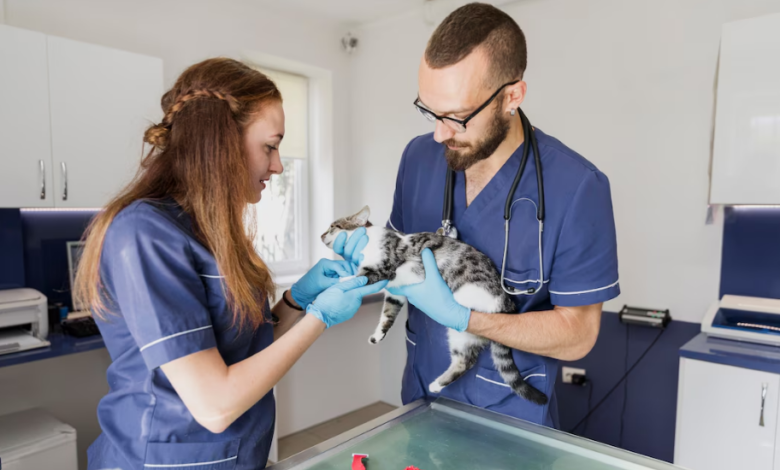What to Expect During Your First Visit to an Orillia Vet

- Preparing For Your Visit To An Orillia Vet
- What To Expect Upon Arrival
- The Initial Consultation Process
- Common Procedures During Your First Visit
- Understanding Costs And Payment Options
- Post-Visit Care And Follow-Up
- Building A Relationship With Your Orillia Vet
- Wrapping It Up
- Frequently Asked Questions
Preparing For Your Visit To An Orillia Vet
Before you head to your appointment with your orillia vet, a little prep work can make the whole experience smoother for both you and your furry friend. It’s not just about showing up; it’s about making sure you get the most out of your visit.
Gathering Necessary Documents
Think of it like getting ready for a doctor’s appointment for yourself. You wouldn’t go without your ID and insurance card, right? Same goes for your pet. Bring any records you have, like vaccination history or previous medical reports. If your pet is on medication, note the names and dosages. This info helps your orillia vet get a clear picture of your pet’s health.
Making A List Of Questions
It’s easy to forget things when you’re in the moment, especially if you’re a bit nervous about the vet visit. Jot down any questions or concerns you have beforehand. This could be anything from diet recommendations to behavior issues. No question is too small! Writing them down ensures you remember to ask and get the answers you need from your orillia vet.
Preparing Your Pet For Travel
Some pets love car rides, others… not so much. Make the trip as stress-free as possible. For cats and small dogs, a carrier is a must. It keeps them safe and prevents them from distracting you while driving. For larger dogs, use a harness or seatbelt. You might want to bring a favorite toy or blanket to help them feel more comfortable. And maybe skip feeding them a big meal right before the trip to avoid any car sickness issues. Trust me, your orillia vet will thank you!
What To Expect Upon Arrival
So, you’ve booked your first appointment with an Orillia vet – great! Wondering what happens when you actually get there? Here’s a breakdown of what to expect.
Checking In At The Reception
First things first, you’ll head to the reception desk. The receptionist is your first point of contact, so be ready to give them your name and your pet’s name. They’ll likely confirm your appointment time and might ask for some initial information. It’s a good idea to arrive a few minutes early, just in case. Sometimes, they’re super busy, and it can take a little while to get checked in.
Filling Out Paperwork
Yep, paperwork. There’s usually some to fill out, especially on your first visit. This might include:
- Your contact information
- Your pet’s medical history (if you have it)
- Consent forms for any procedures
Don’t worry, it’s usually pretty straightforward. If you’re lucky, they might have sent some forms to you beforehand to fill out at home. That can save some time!
Meeting The Veterinary Staff
After you’re checked in and the paperwork is done, you’ll probably be called into an examination room. You’ll likely meet a veterinary technician first. They might ask you some questions about why you’re there and take your pet’s vitals (like temperature and weight). Then, the veterinarian will come in to do the actual examination. Everyone is usually pretty friendly, so don’t be afraid to ask questions!
The Initial Consultation Process
Discussing Your Pet’s Medical History
Okay, so you’re finally at the vet! The first real step is talking about your pet’s history. Be ready to share everything – even if it seems small. Has your pet had any past illnesses? What’s their diet like? Any weird habits? All of this helps the vet get a good picture of your pet’s overall health. Don’t hold back; the more info, the better!
Understanding The Examination Process
Next up: the exam. The vet will check your pet from nose to tail. They’ll look at their eyes, ears, teeth, and listen to their heart and lungs. They’ll also feel around their body to check for any lumps or bumps. This is a normal part of the process, and it helps the vet identify any potential problems early on. It might seem a little invasive, but it’s all for your pet’s good. The vet might also check things like:
- Weight
- Temperature
- Reflexes
Addressing Your Concerns
This is your chance to ask questions! Don’t be shy. If you’re worried about something, speak up. The vet is there to help you understand what’s going on with your pet. They can explain any tests they want to run, what the results mean, and what treatment options are available. It’s a two-way street, so make sure you’re actively involved in the conversation. Lifelearn client ed resources can be helpful for understanding common pet health issues, so don’t hesitate to ask your vet for recommendations.
It’s important to remember that the vet is on your team. They want what’s best for your pet, and they’re there to support you. By working together, you can ensure your pet gets the best possible care.
Common Procedures During Your First Visit
Routine Health Check-Up
Okay, so you’re at the vet, and the first thing they’re gonna do is a general check-up. Think of it like your own doctor’s appointment, but for your furry friend. They’ll look at everything – eyes, ears, nose, mouth. They’ll listen to their heart and lungs, feel their abdomen, and check their skin and coat. This is to get a baseline of your pet’s overall health and catch any potential problems early.
It’s pretty standard stuff, but it’s super important. They’re looking for things like:
- Abnormal lumps or bumps
- Signs of infection
- Dental issues
- Weight problems
Vaccination Updates
Vaccines are a big deal. They protect your pet from some really nasty diseases. The vet will talk to you about what vaccines your pet needs based on their age, lifestyle, and where you live.
Here’s a quick rundown of some common vaccines:
| Vaccine | Protects Against | Frequency |
| Rabies | Rabies virus | 1-3 years |
| Distemper | Multiple viruses | 1-3 years |
| Parvovirus | Parvovirus | 1-3 years |
| Bordetella | Kennel cough | Every 6-12 months |
They’ll keep track of when your pet is due for boosters, so you don’t have to worry about remembering everything.
Parasite Prevention
Ugh, parasites. Nobody likes them, but they’re a fact of life. Fleas, ticks, heartworms, intestinal worms – they’re all out there, and they can make your pet really sick. The vet will talk to you about the best ways to prevent these parasites.
Parasite prevention isn’t just about keeping your pet comfortable; it’s about protecting their health. Heartworm disease, for example, can be fatal if left untreated. Fleas can cause skin problems and transmit diseases. Ticks can transmit Lyme disease and other serious illnesses. So, it’s really important to stay on top of it.
Here are some common methods for parasite prevention:
- Monthly topical treatments for fleas and ticks
- Oral medications for heartworm prevention
- Regular deworming treatments
Understanding Costs And Payment Options
It’s normal to worry about the cost of vet care. Let’s break down what you can expect in terms of pricing and how to handle payments.
Estimates For Services
Before any major procedure or treatment, always ask for an estimate. This will give you a clear idea of the potential costs involved. Vets should be upfront about their fees, but it’s your responsibility to ask. Estimates can vary depending on the complexity of the service and the medications needed. Don’t hesitate to clarify any charges you don’t understand. It’s better to be informed than surprised by a large bill later.
Payment Plans Available
Not everyone can afford to pay for everything upfront, and that’s okay. Many clinics offer payment plans or work with third-party financing companies. Here are some common options:
- In-house payment plans: Some vets offer installment plans directly.
- Third-party financing: Companies like CareCredit specialize in healthcare financing.
- Credit cards: Using a credit card can give you some flexibility, but watch out for interest rates.
It’s worth asking about these options if you’re concerned about affording your pet’s care. Don’t be shy; it’s a common situation.
Insurance Considerations
Pet insurance is becoming more popular, and for good reason. It can help cover unexpected vet bills due to accidents or illnesses. Here are a few things to consider:
- Research different providers: Compare coverage and premiums.
- Understand policy limitations: Know what’s covered and what’s not.
- Consider pre-existing conditions: Some policies don’t cover them.
Pet insurance can be a lifesaver, but it’s not a one-size-fits-all solution. Take the time to find a policy that fits your pet’s needs and your budget. It’s an investment in their health and your peace of mind.
Post-Visit Care And Follow-Up
Scheduling Future Appointments
Okay, so you’ve had your first visit. What’s next? Usually, the vet will let you know if and when a follow-up is needed. This could be for booster shots, ongoing treatment, or just a general check-up to see how your pet is doing. Don’t be shy about asking when you should book the next appointment. It’s easy to forget, and it’s better to be proactive about your pet’s health. Some clinics will send reminders, but it’s always good to keep track yourself. I usually put it straight into my phone calendar so I don’t forget.
Understanding Medication Instructions
If your pet was prescribed any medication, make sure you really understand the instructions. I mean, really understand them. Don’t just nod and smile. Ask questions! What time of day? With food or without? What are the potential side effects to watch out for? It’s better to be safe than sorry. I once gave my cat the wrong dose of medicine (thankfully, she was okay), and I felt terrible. Here’s a quick checklist:
- Dosage amount
- Frequency of administration
- Potential side effects
- Storage instructions
Monitoring Your Pet’s Health
Keep a close eye on your pet after the vet visit, especially if they had a procedure or started new medication. Look for any changes in behavior, appetite, or energy levels. If something seems off, don’t hesitate to call the vet. It’s always better to err on the side of caution. I like to keep a little notebook where I jot down any observations. It helps me keep track of things and remember details when I talk to the vet.
It’s important to remember that every pet is different, and their reaction to treatment can vary. If you notice anything unusual, trust your gut and reach out to your vet for guidance. They are there to help, and they would rather hear from you sooner than later if you have concerns.
Building A Relationship With Your Orillia Vet
Establishing Trust With Your Veterinarian
Building trust with your vet is super important. It’s not just about them being good at their job, but also about feeling comfortable enough to share everything about your pet’s health. This trust comes from consistent, open communication and seeing that they genuinely care about your animal.
- Be honest about your pet’s habits and lifestyle.
- Ask questions, even if they seem silly.
- Follow their advice and see how your pet responds.
A good vet-client relationship is a partnership. It’s about working together to make sure your pet gets the best possible care. It takes time, but it’s worth it.
Communicating Ongoing Concerns
Don’t wait for the annual check-up to bring up something that’s bothering you. If you notice a change in your pet’s behavior, appetite, or anything else, call the vet. Seriously, even if you think it’s nothing, it’s better to be safe than sorry. Keep a log of any changes you see, it will help you remember the details when you talk to the vet.
- Note any changes in eating or drinking habits.
- Track changes in activity levels.
- Document any unusual behaviors.
Utilizing Resources For Pet Care
Your vet isn’t just there for appointments. They can also be a great resource for all sorts of pet-related stuff. Need a good groomer? Ask your vet. Not sure what food to buy? Ask your vet. They usually have recommendations for everything from trainers to boarding facilities. Plus, they often have pamphlets and websites with helpful information.
- Ask for recommendations for local pet services.
- Inquire about reliable online resources for pet health.
- Check if they offer any educational workshops or seminars.
Wrapping It Up
So, there you have it! Your first trip to the vet in Orillia doesn’t have to be scary. Just remember, they’re there to help your pet and answer your questions. Bring any paperwork you have, like vaccination records, and don’t hesitate to ask about anything you’re unsure of. It’s all about making sure your furry friend stays healthy and happy. After your visit, you’ll feel more comfortable and ready for the next one. Just take a deep breath, and know you’re doing your best for your pet.
Frequently Asked Questions
What should I bring to my first vet visit?
Make sure to bring any medical records you have for your pet, vaccination history, and a list of any questions you want to ask.
How can I prepare my pet for the trip to the vet?
Try to keep your pet calm. You can take them for a short walk before the visit or bring their favorite toy to help them feel more comfortable.
What happens when I arrive at the vet’s office?
When you get there, you’ll check in at the front desk. The staff will ask for your name and your pet’s name, and you might need to fill out some forms.
What should I expect during the check-up?
The vet will ask about your pet’s health history and do a physical exam. They will check your pet’s weight, listen to their heart, and look at their eyes and ears.
How much will the visit cost?
The cost can vary depending on what services your pet needs. The vet will give you an estimate before doing any procedures.
What if my pet needs more care after the first visit?
If your pet needs more treatment, the vet will explain what is needed and help you schedule follow-up appointments.




